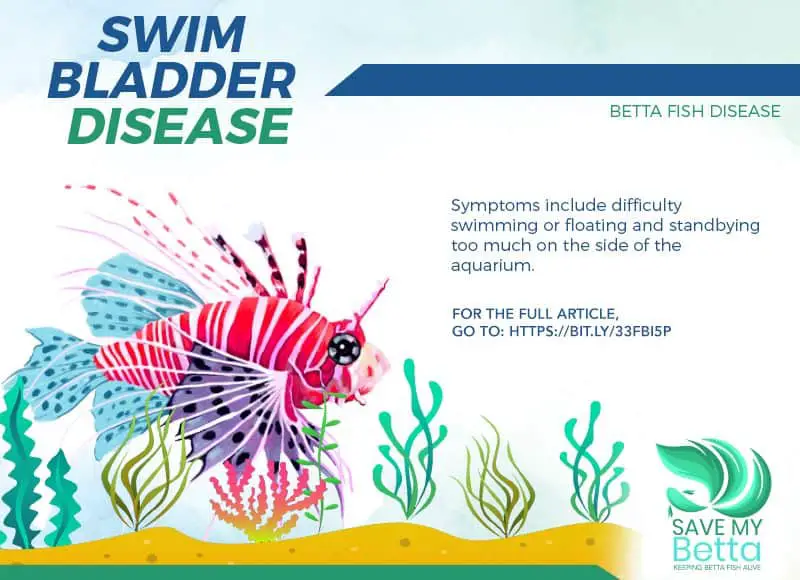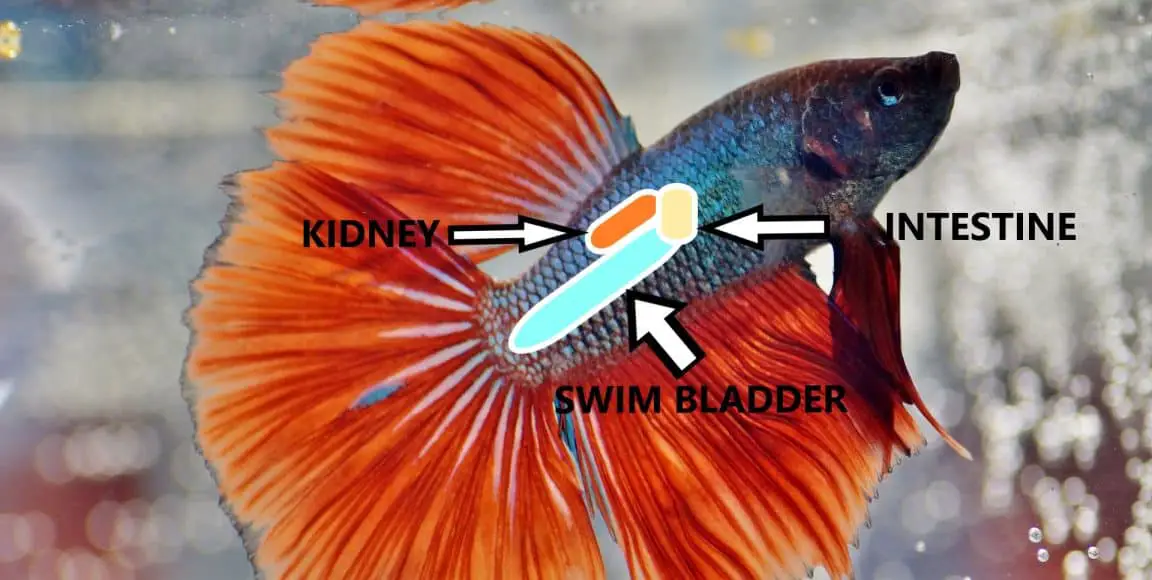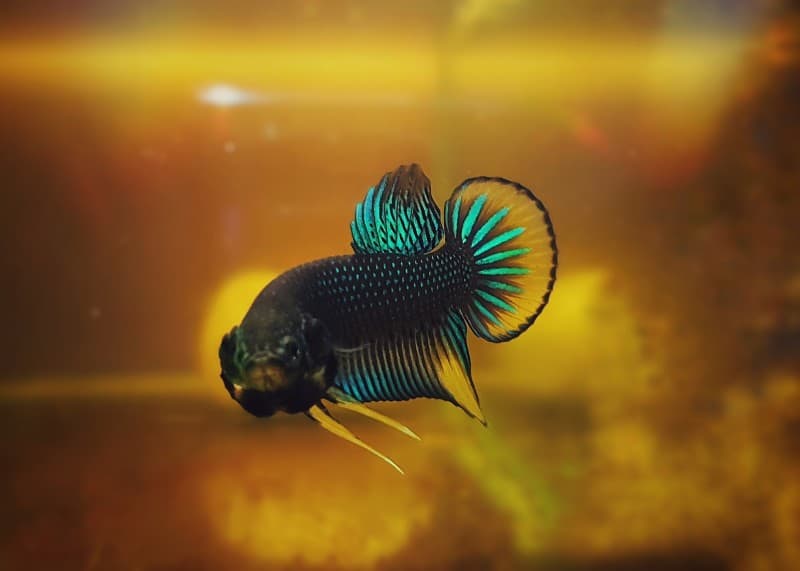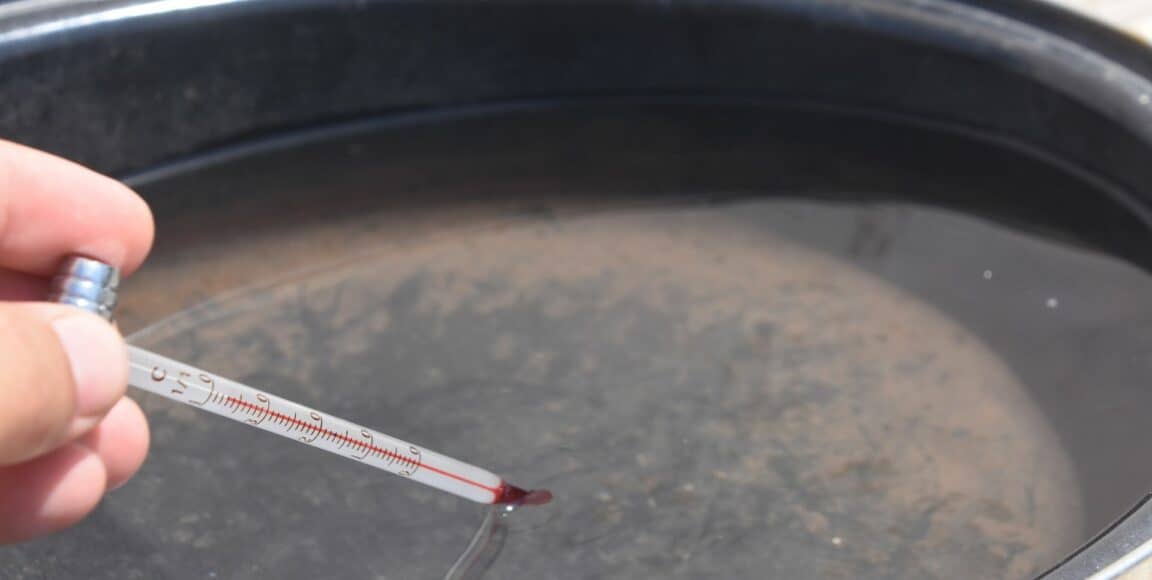Last Updated on January 20, 2023
Have you ever seen betta fish swimming in their tank with an awkward, tail-down posture or struggling to stay upright?
If so, they may be suffering from the dreaded swim bladder disease.
In this article, we’ll discuss the symptoms, causes, and how to cure swim bladder in betta fish.
Get ready to learn how to give your fish the best chance of recovery!
Table of Contents
What is a swim bladder?

A swim bladder, also called the air bladder or gas bladder, is an internal fish organ responsible for maintaining neutral buoyancy.
It helps the fish to remain suspended in one place without sinking or swimming upward against gravity. This mechanism is efficient in conserving the fish’s energy.
You can see the swim bladder near the fish’s spinal cord, kidney, and digestive system. Moreover, it’s covered by a tough outer membrane.
But here’s one thing you need to know. Not all fish have a swim bladder.
Most bony fish, such as carp, goldfish, and betta fish, have one, while different types of sharks, skates, and rays don’t.
This organ is crucial for betta fish’s overall health, but unfortunately, it’s also prone to certain disorders.
What is Swim Bladder Disease (SBD)?

Swim bladder disease (SBD) is a common health issue in betta fish. It’s a condition that affects the swim bladder and can cause them difficulty maintaining their underwater balance.
What are swim bladder disease symptoms in betta?
A fish with swim bladder disease may experience various symptoms depending on the underlying cause.
The common swim bladder disease symptoms include:
- floating face down with its tail pointing up toward the surface of the tank
- betta’s body floats to the top or sinks to the aquarium’s bottom uncontrollably
- having its belly facing up toward the tank
- loss of appetite
- unusual swelling in the abdomen area
- drastic changes in swimming habits
- or labored breathing
It can be a very stressful sight for betta fish keepers.
But being observant and knowing what to look for can be vital in helping your betta fish recover.
What is causing swim bladder disease or swim bladder disorder?

Many factors can cause swim bladder disease. Here are some of them:
Water Temperature
Too hot or cold water can be a major cause of swim bladder disease in bettas.

When the water is too warm (above 78°F or 27°C), the metabolism of your fish increases. This also affects your betta’s response to food. It can result in overfeeding, which can lead to the disease.
Meanwhile, when the water is too cold (below 74°F or 23°C), it slows down the metabolism of your betta fish.
As a result, it becomes unable to digest food properly and can develop swim bladder disease.
Water Condition
Poor water conditions due to pollutants, a high level of nitrates, or poor quality filter media can also contribute to swim bladder disease.
Remember that bettas are particularly sensitive to changes in water conditions. So it’s important to keep ammonia and nitrate levels low in their tank.
Frequent water changes and using quality filter media can help you maintain healthy water conditions and prevent swim bladder disease.
Physical Trauma
This might surprise you, but betta fish can also suffer from swim bladder disease due to physical trauma.
Your betta could be injured if it’s hit by an object or is involved in a fight with other fish, damaging its swim bladder.
It may likewise sustain physical trauma after your betta jumps out of the tank during maintenance, so always proceed cautiously when working in its tank to prevent startling your betta.
Overfeeding
Overfeeding is a prevalent cause of swim bladder disease in betta fish.

When a betta is overfed, their digestion struggles to deal with the large amount of food that has been consumed and can cause swelling in its abdomens.
This abdominal swelling affects the ability of their swim bladders to perform optimally, leading to difficulty maintaining buoyancy or staying afloat.
Overfeeding can also lead to other issues, such as constipation, bloating, and even death if left untreated.
To prevent this from occurring, it’s important to feed your betta an appropriate amount at regular intervals.
Related Article: Why Is My Betta Fish Spitting Out Food?
Infection
Infections by various types of parasites, bacteria, or viruses can directly affect the swim bladder health and functioning of betta fish.
These infections typically occur due to poor water conditions or contact with other infected fish.
In addition, bacteria like Aeromonas and Pseudomonas may infect your betta’s swim bladder.
To prevent these kinds of infections, it’s important to keep your tank clean and regularly replace water to ensure that there are no toxins or bacteria present.
You should also quarantine any new fish before introducing them into your tank to minimize their risk of infection.
Genetics
In rare cases, your betta fish may suffer from a genetic defect leading to swim bladder disorder. Since this is genetics, betta fry (baby bettas) are more likely to suffer from SBD than adult fish.
Unfortunately, there is no way to prevent or cure this disease in this case. Euthanasia is often the only option for fish with genetic swim bladder disorder.
Underlying Conditions
Swim bladder disease can manifest as a symptom of another condition. This includes but isn’t limited to ongoing fin rot disease caused by bacteria or fungi attacking the fish’s fins and skin.
Additionally, it may be a result of a parasite attack.
Intestinal parasites can lead to the fish’s intestines becoming swollen and putting pressure on the swim bladder.
This prevents the swim bladder from having enough space to contain the air needed to maintain buoyancy.
In this case, you’ll need to determine the underlying illness in order to treat swim bladder disease effectively.
As soon as you identify the problem, you can begin treating it and helping your fish get back to a healthy state.
However, this may be easier said than done for new betta fish owners. In this case, it’s best to visit a local fish veterinarian to get professional help.
Related: Betta Fish with Velvet: How to Treat and Prevent it
Do I need a hospital tank to treat swim bladder disease or disorder?
A hospital or quarantine tank is often recommended for swim bladder disease (SBD) in betta fish.
It provides a more controlled environment to monitor the health of your fish. And it also allows you to add necessary medications and treatments.
When my betta fish suffered from swim bladder disease, I put him in a small separate tank because the medication was too strong and could kill the plants in the main tank.
The best thing to do first, however, is to test the water condition in your betta tank.
You can use a master test kit to help determine the water parameters.
Ammonia and nitrites should be 0 ppm, nitrates should not go beyond 20 ppm, and pH should range from 6.5-7.
Additionally, the recommended GH (general hardness) is 3-4 dGH (50-66.7 ppm), while KH (carbonate hardness) should be 3-5 dKH (53.6-89.4 ppm).
Another situation where transferring to the hospital tank is a must is if your betta is suffering from a bacterial infection.
In this case, it’s best to move the fish to a separate tank to avoid it spreading the disease to other tank inhabitants.
Swim bladder disease isn’t contagious, but some bacterial infections are.
How to cure swim bladder disease in betta
The most effective treatment for swim bladder disease (SBD) in betta fish is first to identify the underlying cause and then work towards treating it.
But if it’s difficult to identify, it’s best to seek professional help from a local fish vet. We highly suggest this, especially for new betta fish owners.
Once the underlying cause is identified, you can begin treatment with medications or other treatments depending on what your betta needs.
But just to give you an idea of what you can do, here are a few tips for treating swim bladder disease in betta fish:
Adjusting water parameters and temperature
Adjusting the water parameters can help improve water quality and lower the risk of infection.

Proper pH, hardness, and temperature levels should be maintained in order to ensure that your betta’s swim bladder is healthy and functioning correctly.
Additionally, an aquarium heater may be necessary if the tank environment cannot reach or maintain a suitable temperature range for your fish.
Fasting
To reduce stress on the digestive system, you may also want to consider fasting your betta for several days as part of treatment.
You can stop feeding your betta for about 2-3 days and observe if the symptoms have improved.
Although it might sound cruel, not feeding your betta for a few days isn’t fatal and will probably help him heal.
Just make sure that once your betta recover and you resume feeding, you provide him food gradually and observe for any signs of problems.
Epsom salt bath
Another effective treatment for swim bladder disease is an Epsom salt bath.

Epsom salt baths are used as a laxative and can also help treat constipation and dropsy in betta fish.
The osmotic shift that they create when added to the tank water helps draw excess fluids from the fish’s internal organs, relieving pressure on its swim bladder caused by gas buildup.
The recommended dosage is one teaspoon of Epsom salt per gallon of tank water, and then allow your betta to soak in it for five minutes and not longer than eight minutes.
Then you’ll need to transfer your betta fish to a revival tank before returning him to his main tank.
Although Epsom salt bath is effective, it’s quite difficult to do and should only be attempted if you’ve had some experience in treating fish disease.
This is because prolonged exposure to Epsom salt can cause serious health issues for your betta, too.
Medication
If all else fails, there are a variety of medications available that can be used to treat bacterial infections as well as parasites that may be causing the swim bladder issue.
Methylene blue is one of the most popular treatments for swim bladder disease.
It is an antifungal medication that helps battle parasitic or bacterial infection.
It also helps improve oxygen levels in the tank, which can help your fish breathe easier.
However, if you want to try this method, you should consult a vet for the correct dosage and instructions.
This is especially important if you’re not familiar with fish medication, as it can be quite tricky to get the dosage right.
Surgery
Although this might not be necessary in most cases, surgery may be required if your betta’s swim bladder is damaged beyond repair.
This type of surgery can be quite complicated and is best done by a professional fish vet with the experience and knowledge to do it safely.
Related: Betta Fungal Infection: Symptoms and Best Treatment
How to prevent swim bladder disease from happening?
Prevention is always better than cure. Fortunately, there are a few simple steps you can take to help prevent swim bladder disease from occurring in the first place.
First, ensure that your betta’s tank is kept clean and water parameters are regularly checked and adjusted.
Also, try not to overfeed your betta fish as this can lead to a buildup of gases in the digestive system and cause swim bladder problems.
I suggest you starve your betta once a week for about 24 hours.
This will keep your betta’s digestive system healthy and functioning properly by helping to flush out any waste that has built up inside it.
Besides these basic steps, you can also do the following:
Change your betta fish’s diet
Evaluating what your betta has been eating and adjusting their diet accordingly is essential for treating swim bladder disease.
For instance, if your fish has been overeating protein, replace it with more vegetables or other high-fiber foods such as cooked peas or zucchini slices.
Just make sure to cut them as small as possible so your betta can swallow them easily.
You may also want to consider feeding freeze-dried or live foods, such as blood worms or daphnia, that are high in fiber and easy to digest.
Provide a good-sized tank
Another important factor to consider when it comes to preventing swim bladder disease is tank size.
Make sure that your betta’s tank is large enough for them to move around comfortably and get the exercise they need.
This will help keep their digestive system healthy, so gas doesn’t accumulate in it and cause swim bladder issues.
We suggest that you invest in at least a 5-gallon tank.
Besides giving your betta enough room to swim, a bigger tank size can also provide more stable temperature and pH levels.
This, in turn, will help reduce stress and improve your betta’s overall health.
Invest in a good filtration system
A good filtration system can help remove waste and other toxins that can cause swim bladder disease in betta fish.
It will also keep your tank water clean and free of harmful bacteria and parasites.
Many kinds of filtration systems are available, such as sponge, hang-on-the-back, canister, and power filters.
Do your research to find the best one for your tank size and budget.
Frequently Asked Questions
Is swim bladder disease contagious?
No, it’s not contagious. Your betta fish can’t pass it from one fish to another.
However, the bacteria or parasites that can cause swim bladder disease in betta fish can spread to other fish in the same tank if they are not adequately treated.
Is swim bladder disease fatal?
Yes. It can be fatal if left untreated. That’s why taking the necessary steps to prevent and treat swim bladder disease as soon as possible is important.
Can a fish recover from swim bladder disease?
Fortunately, you can reverse or cure swim bladder disease if caught early and treated correctly.
However, some cases may require more aggressive treatment, so it’s always best to consult your vet for the best course of action.
Can swim bladder disease fix itself?
No. Swim bladder disease will not go away on its own. As a betta fish owner, you must take the necessary steps to prevent and treat it.
How do you know if your fish has swimbladder disease?
The common symptoms include an inability to swim, a bloated or swollen belly, and loss of balance.
Conclusion
Swim bladder disease is a common problem for betta fish, but it can be prevented and treated with the proper steps.
Clean water, proper tank size, a good filtration system, and a balanced diet are all critical factors in preventing swim bladder disease.
However, swim bladder disease can still occur despite the best prevention methods.
If your betta shows signs of swim bladder disease, it’s best to consult your vet for the most effective treatment plan.
But if you’re on your own and want to try some home remedies, check out the first four tips to cure your betta fish from swim bladder disease that we’ve provided above.
